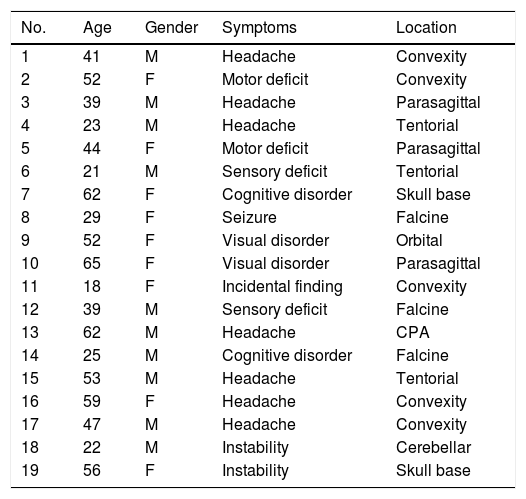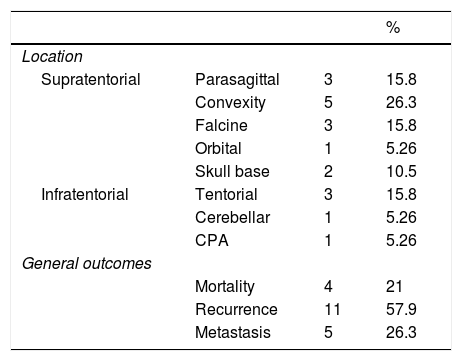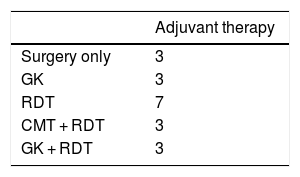Intracranial hemangiopericytoma (HPC) is a rare central nervous system tumor characterized by its low incidence, high rate of local recurrence and risk of metastasis. The main objectives of this paper are two: to show the results in the treatment of HPC in our institution in the last 20 years and to make a review of the literature on this topic.
MethodsRetrospective review that includes patients diagnosed with intracranial solitary fibrous tumor/hemangiopericytoma (TFS/HPC) that have undergone surgery from 1997 to 2017. It includes patients that had nuclear expression of STAT6 (detected by immunohistochemistry) and grade II/III histopathological diagnosis (defined by the World Health Organization in 2016). We collected demographic data, tumor characteristics, treatment and survival of these patients.
ResultsA total of 19 patients fulfilled inclusion criteria. The median follow up was 96 months (12–230). The mortality rate was 21% (n = 4). The median follow up survival was 19.16 years. 57.9% of patients presented at least 1 tumor recurrence (n = 11) (recurrences of 6%, 67% y 90% at 1, 5 and 10 years). Five patients presented extracranial metastasis. Patients with tumors <6 cm had greater survival (p < 0.05).
ConclusionsA series of patients undergoing TFS / HPC were presented according to the new WHO criteria. Size is a predictor of survival. Currently there are no validated criteria for surgical resection in this pathology. A classification with surgical guidance would be useful.
Los hemangiopericitomas intracraneanos (HPC) son tumores de muy baja frecuencia, alta recidiva local y riesgo de metástasis extracraneal. El objetivo del siguiente trabajo es presentar los resultados en el tratamiento de los HPC en nuestra institución en los últimos 20 años y realizar una revisión de la literatura del tema.
Material y métodosSe realizó un estudio retrospectivo que incluyó a los pacientes con diagnóstico de tumor fibroso solitario / hemangiopericitoma (TFS/HPC) intracraneanos intervenidos quirúrgicamente en el periodo 1997−2017. Se incluyeron pacientes con inmunomarcación positiva para STAT-6 y grado histológico II-III. Se recabaron datos demográficos, características tumorales, tratamiento y sobrevida de estos pacientes.
ResultadosUn total de 19 pacientes cumplieron los criterios de inclusión. La mediana de seguimiento fue de 96 meses (12–230). La mortalidad fue 21% (n = 4). La mediana de sobrevida para todos los pacientes fue de 19,16 años. El 57,9 % presentaron al menos una recidiva tumoral (n = 11) (con una recurrencia del 6%, 67% y 90% a 1, 5 y 10 años respectivamente). Cinco pacientes presentaron metástasis extracraneal. Tuvieron mayor sobrevida los pacientes con tumores < 6 cm (p < 0.05).
ConclusionesSe presentó una serie de pacientes operados de TFS/HPC según los nuevos criterios de la WHO. El tamaño es un factor predictor de sobrevida. Actualmente no existen criterios validados de resección quirúrgica en esta patología. Una clasificación con orientación quirúrgica sería de utilidad en el futuro.
Article

If it is the first time you have accessed you can obtain your credentials by contacting Elsevier Spain in suscripciones@elsevier.com or by calling our Customer Service at902 88 87 40 if you are calling from Spain or at +34 932 418 800 (from 9 to 18h., GMT + 1) if you are calling outside of Spain.
If you already have your login data, please click here .
If you have forgotten your password you can you can recover it by clicking here and selecting the option ¿I have forgotten my password¿.

















